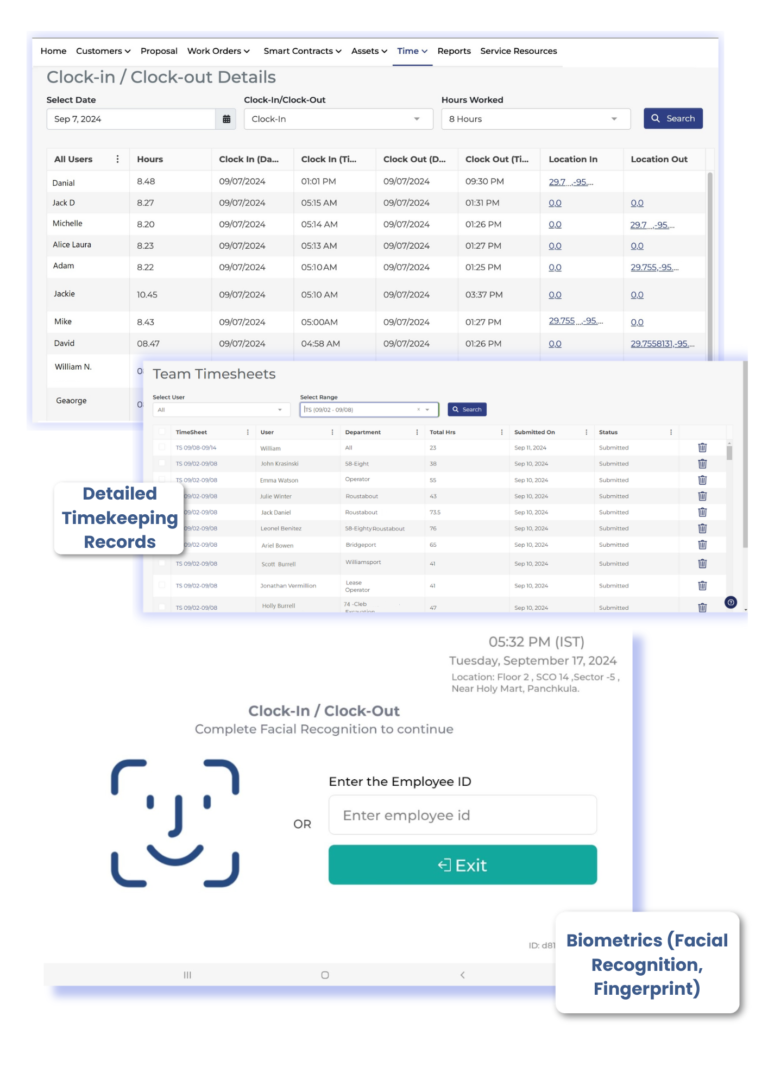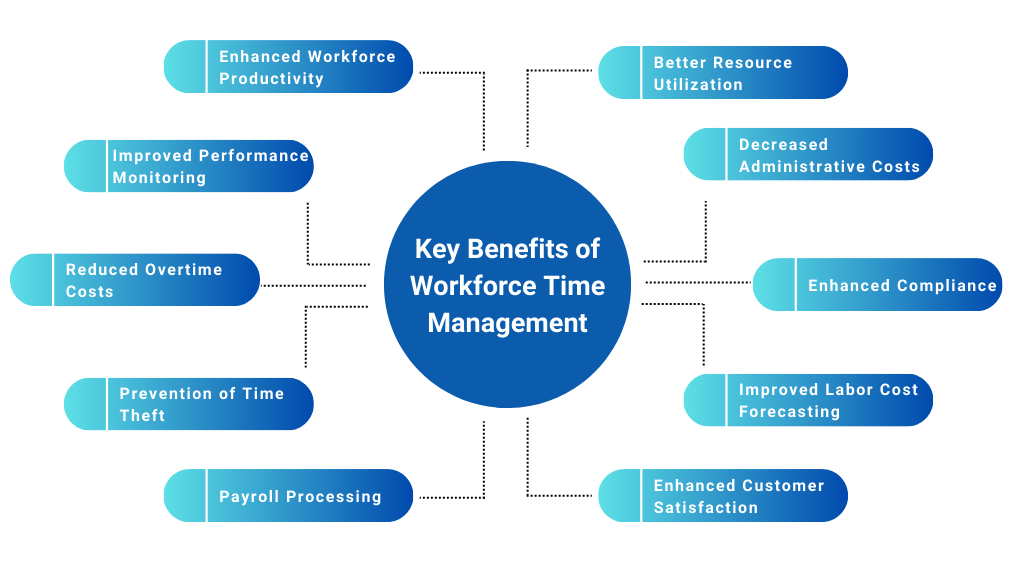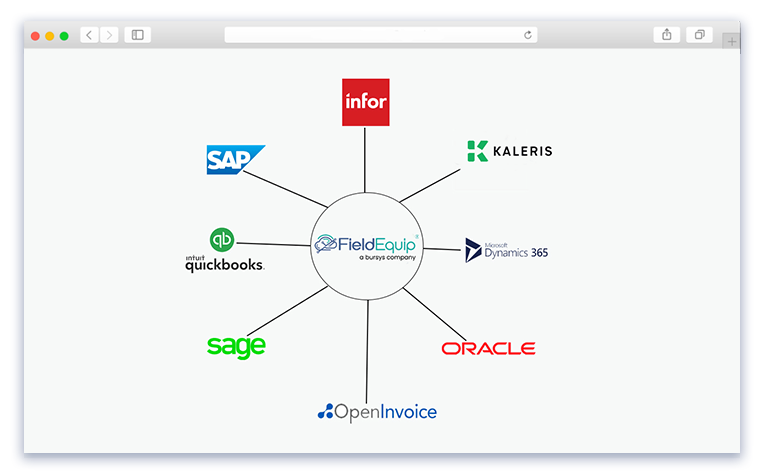Workforce time management is a core issue that every field service organization struggles with. Efficiently managing your employees’ time is crucial for productivity and operational success.
Yet, it’s not just about keeping track of hours worked. It’s about creating a system that optimizes schedules and ensures compliance with labor laws, all while reducing administrative overhead and cutting costs.
The manual process of collecting timesheets and verifying them for payroll is not only time-consuming but also prone to errors. This is where robust workforce time management software comes into play.
Let’s examine the key benefits and features of effective workforce time management, along with common challenges and best practices for successfully deploying these solutions.

Workforce time management is a comprehensive approach to efficiently managing employees’ working hours in order to enhance productivity and operational effectiveness.
This involves tracking, planning, and optimizing the use of employees’ time to ensure that they perform tasks efficiently and utilize resources effectively.
Time tracking solutions help ensure that employees spend more time on productive tasks and less on waiting or administrative duties.
By optimizing scheduling and dispatching, you can minimize idle time and increase job completion rates. This leads to a more streamlined workflow where technicians are able to handle more jobs in a day. As a result, overall productivity of your oil and industrial field services company improves.
Additionally, employees equipped with mobile time management tools can receive real-time updates on job assignments, their information, and inventory levels. Immediate access to this crucial information enables faster decision-making and task execution.
Finally, capturing data on-site in real time helps maintain accurate records. This reduces the need for manual back-office data entry, which can boost productivity even further.

Your employees aren’t as effective as they could be. According to research, an average employee wastes at least one hour daily on non-work-related activities.
Workforce time management systems provide detailed metrics and analytics on employee performance. Managers and HR teams can track key performance indicators (KPIs) such as job completion rates, response times, and customer satisfaction scores.
This enables more precise performance evaluations and helps identify areas for improvement. Managers can conduct informed performance reviews, offering constructive feedback based on concrete data.
A time tracking solution helps accurately track and manage employees’ working hours. This can significantly reduce unnecessary overtime costs. By optimizing scheduling, companies can ensure that their employees complete tasks within regular working hours.
As a result, they can avoid the financial burden of overtime pay. This leads to more predictable labor costs and better budget management.
Time theft and buddy punching (when one employee clocks in for another) are common ways of artificially inflating work hours. They can lead to significant payroll costs and are difficult to detect without proper time management systems.
Employee productivity tools with biometric or GPS tracking features can prevent such practices. They can ensure that payroll expenses reflect actual working hours and reduce unnecessary labor costs.
Automated time tracking and attendance monitoring systems ensure accurate recording of employee work hours. This eliminates discrepancies and errors in payroll processing, ensuring that you pay your employees correctly for the hours they have worked.
Accurate payroll processing reduces administrative burdens and the risk of costly payroll errors, enhancing overall financial efficiency.
Workforce time management solutions optimize the allocation of resources. They help ensure that managers schedule the right number of technicians based on workload demands, avoiding overstaffing and understaffing.
This balance helps in managing labor costs more effectively, ensuring that payroll expenses align with actual operational needs without overextending the budget.
Manual time tracking and payroll processing can be time-consuming and prone to errors. This can lead to higher administrative costs. Workforce time management solutions automate these processes, reducing the need for extensive administrative oversight.
This automation frees up administrative staff to focus on more strategic tasks, ultimately reducing overhead costs associated with manual payroll management.
And it’s not just cost reduction. Studies show that businesses can earn a revenue increase of up to 61% by better tracking employee time.
Non-compliance with labor laws regarding working hours, breaks, and overtime can result in costly fines and legal fees. Not something that your oil and industrial field services company needs.
Workforce time management systems ensure compliance by automatically enforcing labor regulations and providing accurate records of employee working hours. This reduces the risk of legal issues and the associated costs, safeguarding the company’s financial health.

A centralized dashboard provides a comprehensive view of all field operations, including job statuses, technician locations, and performance metrics. This enables managers to monitor operations more efficiently, identify bottlenecks, and make data-driven decisions to improve overall performance.
Managers and human resources teams can also use this data to forecast labor costs more accurately. Thus, they can plan budgets more effectively and make informed decisions about staffing and resource allocation. Such improved forecasting helps maintain financial stability and avoid unexpected labor cost overruns.
With optimized scheduling and real-time information access, technicians can respond to service requests faster and deliver higher-quality service. This leads to improved customer satisfaction, as teams can resolve issues promptly and effectively.
Workforce time management systems help maintain high service standards, contributing to a positive reputation and customer loyalty.
Effective field service time management software is essential for optimizing operations and ensuring high-quality service delivery. Here are the key features that make such software indispensable:
Field service management software enables technicians to capture and access data in real time using mobile devices. This includes customer information, work order details, and equipment status.
Real-time data capture ensures that all stakeholders have up-to-date information, leading to quicker decision-making and more efficient service delivery.
Automated scheduling and dispatching tools help assign the right technician to the right job based on their skills, location, and availability.
They consider various factors such as job priority, proximity to the site, and employee expertise to create optimal schedules. This reduces downtime, minimizes travel time, and ensures that service requests get prompt resolution.

Effective time management software streamlines the creation, assignment, and tracking of work orders.
Technicians can receive work orders directly on their mobile devices, update their status in real time, and record any issues or additional tasks required. This ensures that employees manage work orders efficiently from initiation to completion, enhancing overall productivity.
Field service management software provides tools for managing spare parts, equipment, and other resources. Technicians can track inventory levels, access nearby stocking locations, and order parts as needed.
This feature ensures that technicians have the necessary resources to complete their tasks, reducing delays and improving first-time fix rates.
Real-time visibility into field operations is crucial for effective management. Field service tracking software provides tools for tracking the location and status of field workers, monitoring job progress, and ensuring compliance with schedules.
This allows managers to make informed decisions, address issues promptly, and optimize resource allocation.
The software generates detailed reports on various metrics such as job completion rates, response times, and technician productivity.
Meanwhile, analytics tools help managers analyze data trends, make data-driven decisions, and continuously improve service delivery.
The solution provides features such as equipment-specific checklists, safety protocols, and regulatory compliance tracking. These tools help maintain high service standards, ensure adherence to industry regulations, and minimize risks associated with non-compliance.
Deploying field staff management software can significantly enhance operational efficiency, but the process is not without its challenges.
Here are some common obstacles your organization may face and best practices to overcome them:
One of the primary challenges companies face is resistance from employees and management to adopt new technology. This often stems from a fear of change, a lack of understanding of the new system, or concerns about job security.
Employees may feel overwhelmed by the prospect of learning new tools. Meanwhile, managers might be skeptical about the benefits versus the disruption to current workflows.
Integrating field service tracking software with existing systems can be complex and time-consuming.
Many companies have legacy systems that may not easily interface with modern software, leading to data silos and workflow interruptions. Ensuring seamless data flow between different platforms is crucial for maintaining operational efficiency and avoiding disruptions.

Providing comprehensive training and ongoing support is essential. It can not only facilitate the smooth adoption of new field staff management software but also help retain talented employees.
In fact, research shows that 45% of employees are more likely to stay in their roles if they receive more training. Training programs should be custom for different user groups, ensuring that both field technicians and back-office staff are comfortable using the new system.
Additionally, offering continuous support and resources, such as user manuals, video tutorials, and a helpdesk. They can help address any issues that arise and build confidence among users.
Workforce time management is crucial for the success of any field service organization. By implementing digital tools for time tracking, scheduling, and real-time data capture, companies can optimize employee performance and minimize administrative burdens.
Ready to transform your field operations for the better? Schedule a demo to see FieldEquip in action.
Would you like to have a free demo or have any questions about FieldEquip?
US Corporate Headquarters 1011 S. Hwy. 6, Suite 117 Houston Texas 77077 US